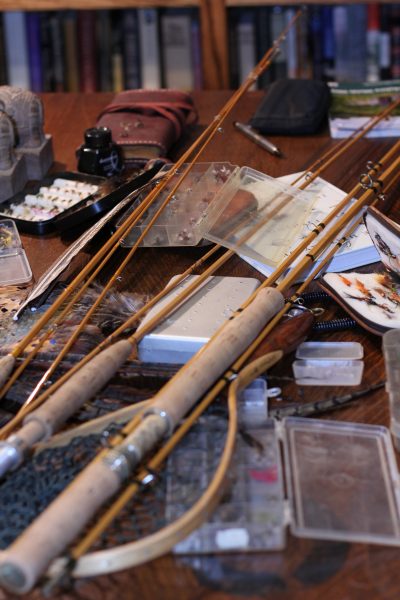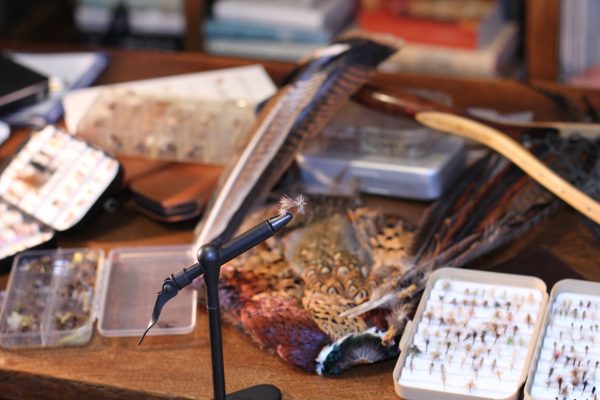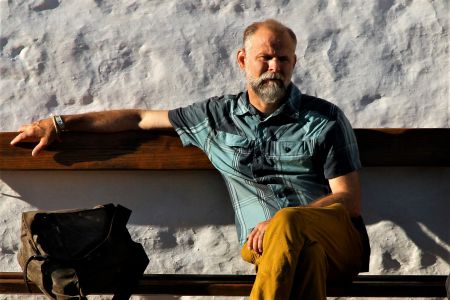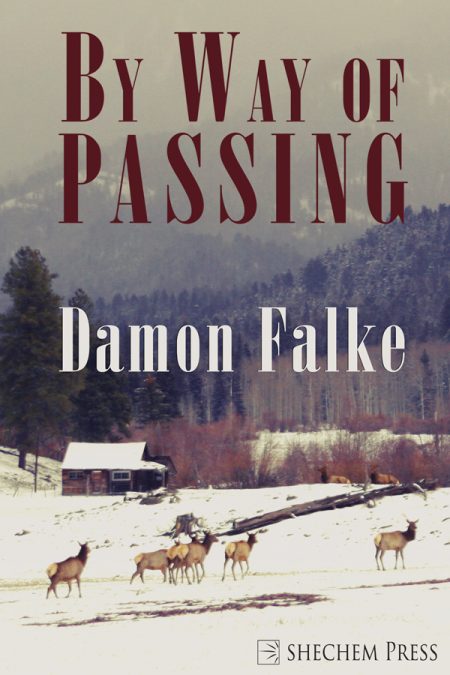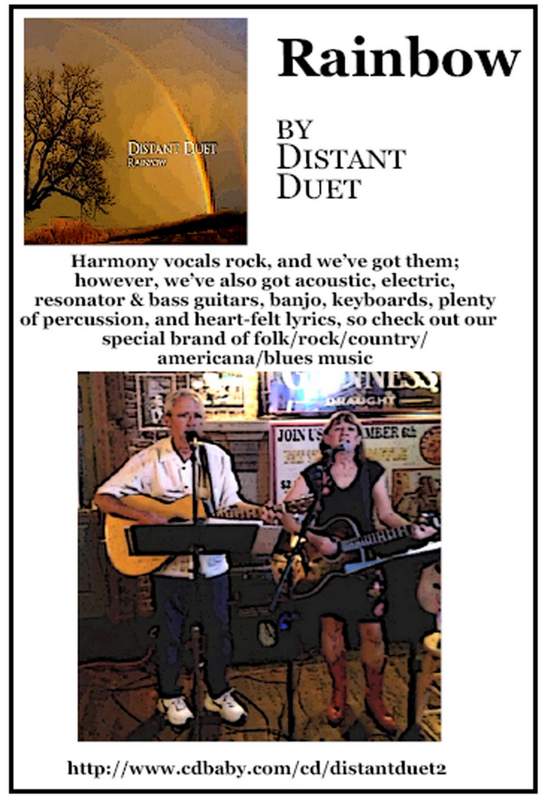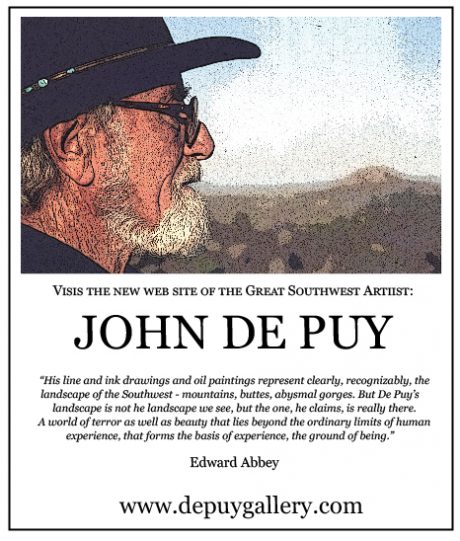“And we marched on in the direction of the wilderness of Moab.”
Deuteronomy 2:8
“We went into the land to which you sent us, and it does flow with milk and honey! Here is its fruit.”
Numbers 13:27
homewater
When my family and I first headed down Blue Hill in our overly packed Oldsmobile and U-Haul truck, I felt a nudge of disappointment. The country ahead of us, this new place to live, was a desert, shaped, as it were, by red canyons and glimpses of parched vacancy—not mountains. Mountains held trout, and deserts, from what little I knew, did not. This desert country we drove across didn’t smell like mountains. I rolled down my window to get a whiff. The landscape smelled as it appeared, which was dry and nearly barren. There were aromas of something spicy, something vaguely foreign in the air. That’s how different the landscape seemed from other places I had lived or traveled in my young life. This was desert. This was Moab. But where, I worried, would I learn to fly fish?
In less than nine months, I had my answer.
The headwaters of the creek begin close to 10,000 feet in the mountains. There are two small lakes feeding the creek. Below these lakes, the creek flows through conifers and benches of aspen. The water up there smells cold, smells like trout. Out of the high country, the water descends quickly and enters a desert where temperatures in the summer regularly run upwards of a hundred degrees. Not surprisingly, the desert section of the creek is very different from where the creek starts in the mountain. The mountain water is swift and icy. Trout live in pockets on the downside of heavy stones, where the creek collapses into tiny pools. In the desert, the water moves slower. The banks are crowned with willows. Where the willows and their cottonwood neighbors enter the creek, either from erosion or any number of possibilities, deep pools form and provide habitat for a variety insects and fish, including fish that are not trout.
Given the choice of fishing the mountain or desert stretch of water, I fished most often in the desert. The trout on average were a couple of inches bigger. The fishing was more technical. The desert water was also where I caught my first trout while fly fishing entirely by myself. April could have been the month when I caught the fish, though it could have been May, too. The water was warm enough to stir up a few bugs, though not warm enough to cause run-off.
A grown-up told me that I would not catch a fish in the creek at that time of year. He said the water was too cold. What this gentleman could not understand is that I did not care whether I caught a fish or not. I wanted to go fishing with a fly rod and fly on moving water. Perhaps it is predictable that I did catch a fish—a ten inch brown trout, with a crimson adipose fin that looked very much like a drop of wet, fresh paint. Naturally, I was proud of the catch. I returned the fish to the creek, and later told the gentleman that I had, after all, caught a fish. Probably I tried to play it cool, as though catching a trout in early spring water was standard procedure for me. The man, to his credit, only shrugged.
I return in memory more often to the pool where I caught the fish than to the fish itself. Upstream, maybe fifteen feet from where I made my cast, the creek formed a waterfall. The waterfall plunged from a two foot drop over a slab of sandstone. The pool opened beneath the falls. Around its circumference, the water turned in a fantastic blue-green color, like a color band that ribbons around a planet. The creek sluiced away from the pool, entering a narrow channel between two thin ridges of stone. I wasn’t much of a fly caster then, so I aimed my cast at the heart of the pool.
Where the creek narrowed would have been a better place to cast. Likely there would have been a larger trout there. The fishing lesson is not to cast over water where there could be fish. What I saw, what I took in was the pool itself, the blue-green swirling at the water’s edge and the flow of the creek. These are what I have kept close.
I continue to frame worlds and experiences in ways similar to when I was a child. I see snapshots of landscapes and memories. I see sun glitter from a ferry in the Adriatic and a boat called Patroclus, passing over the sea. I recall the view from a balcony in Aegina, where the rails were cut in faint arabesque. There was an orchard near Bovec where just one apple hung from a tree. There was a pathway of broken steps in Trieste, leading to an old explorer’s home. Then there was this pool on a desert creek where I first fished alone. On and on I see them.
feathers
In those early months after arriving in Moab, I began learning how to fly fish. I had to learn how to string a rod, where to cast, how to untangle a line, how to tie a leader to a line, how to tie a fly to a tippet without knowing, for years, what the hell a tippet was, and how to choose a fly that would give me the best chance of catching a fish. Those stately fishermen on the covers of Fly Fisherman appeared as though they had never tangled a line or made poor casts, let alone caught small fish. I wasn’t entirely stupid, however. I knew well enough that photographs are photographs. Whoever posed for them or took them wanted to convey an image of a more than competent fly fisherman. Plus, there was so much polish. There was so much gloss. I didn’t want to wear a blazing chamois shirt or a baseball cap. I wanted to fish in a hard-worn fishing vest and beat up fedora, and I desperately wanted the expertise.
The flies Uncle Lloyd had given me were big and gaudy. They were poorly tied. Their heads came unraveled. Wings fell away. They were tied with impossibly bright feathers. Impossible in the sense that they bore no resemblance to any color of any feather anyone would ever find in nature. I remember opening a Perrine fly box and veritable powder puffs of color fell out of the box. I caught fish with those flies. Lloyd used them. Yet I wanted to fish with more exact flies. I wanted to fish with flies tied thinly, with natural materials on small hooks— flies that looked like flies, in other words. I didn’t get rid of Lloyd’s flies. How could I? Nevertheless, I started to lean away from my own beginnings.
local
Before I began to tie flies, I purchased them. In those days I purchased flies from Briggs Sporting Goods & Hardware in Moab. Briggs disappeared from Moab years ago. A grocery store operates in the building where Briggs used to reside. Briggs was not a high-end sporting goods store. It wasn’t the sort of fishing shop that thrives in towns such as West Yellowstone and Jackson Hole and Livingston, Montana, and dozens of others. I would guess high-end fishing shops are standard fare in most western towns these days. And although I’ve been inside many a swanky fishing store, I’m not sure how some of them stay in business. There can’t be many people dashing out to buy a $135.00 trout fishing net.
For its time and place, Briggs was a typical outdoor/hardware store. About half the store was sporting goods, which included different types of fishing poles, blue and white enamel cups, plates and bowls, a dozen or so rifles and shotguns, reels of familiar brands, and a few tents and sleeping bags. The other half of the store carried hardware. There were bins of nails and screws, nuts, bolts, fasteners. There were tape measures, rope and duct tape. There might have been lumber, though I didn’t pay attention to building materials. I did, however, pay attention to tack and husbandry goods. I have never owned a horse, chicken or goat in my life, but feed buckets, salt blocks, horseshoes (not the throwing kind) and lead ropes hold my interest.
The flies at Briggs were sold from a display case on the glass countertop at the front of the store. A sample of each fly was fixed to a plastic stub and labeled inside the case. The flies were neat, well-proportioned, and tied so that the hook eyes didn’t gum-up with head cement. The selection was solid: Hare’s Ear Nymph, Montana Nymph, Trueblood Nymph, Brook’s Stone Fly, Pheasant Tail Nymph, Muskrat Nymph, Zug Bug, Prince Nymph—not of the beadhead variety— Muddler Minnows, Mickey Finns, Yellow Wooly Worms, Olive Wooly Worms, Black Wooly Worms, and Rubber Legs. The store had plenty of terrestrials and dry flies, including: Dave’s Hopper, Joe’s Hopper, Royal Humpy, Red Humpy, Yellow Humpy, Royal Coachman, Royal Wulff, Coachman, Rio Grande King, Adams, Elk Hair Caddis, Renegade, Bivisible, Griffith’s Gnat, Black Gnat, Mosquito, and Grey Hackle Peacock. The last in the batch, the Grey Hackle Peacock, I fished with and still fish with for no other reason than it has a pretty name, a kind of poetry to it.
The fly rods at Briggs were decent enough. In the short time between first casting a fly rod and being able to purchase one, I had equated a certain fishing competency with a fairly exact aesthetic. I wasn’t naïve enough to believe good fishing gear made for a good fisherman, yet good fishermen did fish with good gear. There was a tailored quality to what those men fished with and how they presented themselves as fishermen. A Filson shirt, a stained khaki vest, and a bamboo rod make for a damn handsome style. If Joe Brooks, Curt Gowdy and Ted Williams were all great fishermen (as they were) and dressed down when they fished (as they did) and used the sort of gear and flies I have described (as they used) then maybe their methods deserved a little study. It’s worth mentioning, too, that these men and even their kits, as I’ve generally described them, were considered old fashioned by the time I started fishing. That was okay with me.
Owning a bamboo rod was a fantasy, and Filson wasn’t a company I had heard of. I could have talked more about Ted Williams’ batting averages than I could have talked about his fishing adventures. Regardless, I needed a fly rod with two basic requirements—a cork grip and a slender taper. Seemingly, that’s what the better fly fishermen fished with, thin rods with cork grips. So, I purchased my first fly rod. It had a black foam grip and a butt section about the size of a pill bottle. I think the rod cost around $30. Nonetheless, I felt tender for the rod, though I probably would have felt tender for any fly rod I could have purchased.
I am a little ashamed to admit that I bought another fly rod as soon as I could afford one. The new fly rod was a better rod than the first. It had a cork grip, a slender taper and responded well to taking fish. I purchased the rod at Gene Taylor’s Sporting Goods in Grand Junction, Colorado, a sporting goods store for real outdoorsmen in those days. I didn’t get rid of the old rod, of course. To do so would have been too painful.
lessons
Learning about flies and fly rods, learning about creeks and rivers, learning how to appreciate the desert, these lessons came slowly to me. Some of them are better understood because I can look back on them, summoning the proverbial wisdom of hindsight, I suppose. Even so, I am confident that I valued some of those lessons from the start.
We suspect often that our returns are merely nostalgic. Perhaps it is true that we cannot see the world outside of ourselves. As such, searching into a past cannot be a purely unaffected experience. We have a tendency to mistrust experience imbued with casual sentiment, even though sentiment is a shared part of our human journey. However, to suggest that someone’s place, someone’s West, so to speak, did not exist is a tad narcissistic. It also may be missing the point. We don’t create mythologies simply or only to empower ourselves, either culturally or privately. Mythologies, whether from an ancient tradition or the last one hundred years, can provide a framework from which we may seek our more virtuous selves.
Consider the Iliad. The story begins with Achilles, the raging hero of the Greeks, but ends with Hector, who is arguably the most virtuous character in the epic. We can say that Hector died a terrible death under the brutal hands of Achilles—so much for compassion as a virtue. Or, we can recognize that Achilles died a downright ridiculous death, shot in the heel by the biggest fop the Trojans could produce. Well, which is it? The ancient Greeks used the Iliad as a sort educational text for centuries. Pindar admired Homer and the honor that he, Homer, sung into his characters. Alexander the Great, on the other hand, slept with a copy of the Iliad under his pillow, along with a dagger, and reading about him, one gets the idea that young Alexander never aspired to be Hector.
Jumping ahead 2,700 years or thereabouts, we can consider which and whose West is it? The Searchers or “Dear John Wayne”? The Brave Cowboy or Pieces of White Shell? To pursue these questions, or related ones, depends on what we need, what we remember, what we have studied, what we wish to believe. I am not dismissive of facts, but perspective holds significant claim. Perhaps the best we can collectively do is to be virtuous while not dismissing the virtue of another’s story.
To borrow from T.S. Eliot, an admitted borrower himself, moving to Moab and learning to fly fish were both my end and my beginning. Dozens of lessons were to come. Among those, came the mercy of living quietly in what was once a quiet town. There was the desert’s enchantment. There were people to meet, some of whom to love. There was season after season spent on the desert creek, the world in a sense becoming with every trip. I wonder now if my returns were, somehow, already taking shape. In the end, we can only return, in one sense of another, to those places we have loved truly.
Damon Falke is a regular contributor to the Canyon Country Zephyr. He is the author of Now at the
Certain Hour, By Way of Passing, and most recently the short film Laura or Scenes from a Common
World. You can find out more about his work at damonfalke.com, shechempress.org and on
Facebook.
To comment, scroll to the bottom of the page.
Don’t forget the Zephyr ads! All links are hot!


